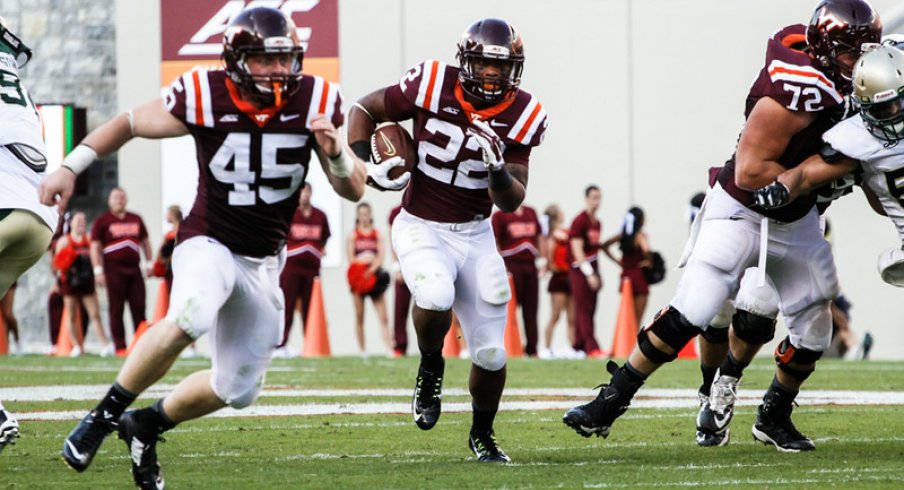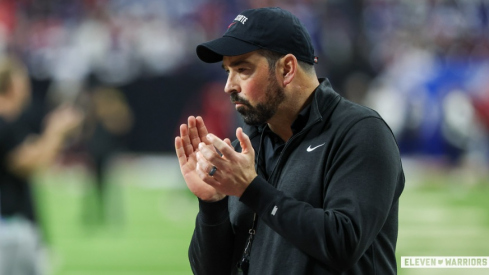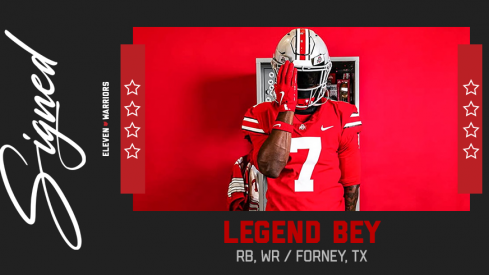Don't let the numbers fool you.
Coming in unranked and off a win against FCS opponent William & Mary in which they played 17 freshmen, the Virginia Tech Hokies will offer a huge challenge for Ohio State on Saturday night. With young playmakers on offense and a defense as well-coached as you'd expect from Frank Beamer and coordinator Bud Foster, the visitors from Blacksburg present some serious matchup problems for Urban Meyer's squad.
Offense
As they showed in week one, the Hokies present an offensive attack very similar to that of the Buckeyes under Meyer. With junior quarterback Michael Brewer making his first start after transferring from Texas Tech, the Hokies have implemented a number of Air Raid principles and will at times operate at a hurry-up, no-huddle pace.
But make no mistake, much like OSU the Hokie offense centers around the power running game and builds from there. Offensive coordinator Scott Loeffler prefers a zone-blocking scheme, splitting carries between two freshmen running backs in #22 Shai McKenzie, the reigning ACC rookie of the week, and #42 Marshawn Williams. Both backs are 6'1" and listed above 220 lbs, and will remind Buckeye fans of Carlos Hyde in their ability to find a hole and consistently fall forward for extra yards.
(Author's note: Many videos and screen-caps are courtesy of our friends at Va Tech blog The Key Play. If you aren't familiar with their in-depth breakdowns, they're definitely worth a look before Saturday night. Their WORK ON TWITTER is also excellent, especially during the season.)
Though often run from a shotgun or pistol formation with multiple wide-outs, Loeffler still finds a way to get plenty of blockers on the field to help guide the way for McKenzie and Williams. The Hokies often operated with tight ends Ryan Malleck (#88) and Bucky Hodges (#7) on the field at the same time, lining them up all around the field. Their versatility is the key to VT's no-huddle attack, allowing them to line up in a power formation one play, and a 5-wide formation the next without making any substitutions.
Hodges often lined up in the slot and showed more playmaking than blocking ability, but his presence alone at 6'6" and 244 lbs is overwhelming for defensive backs, and is enough to neutralize linebackers and defensive ends in the running game. His combination of size and athleticism is very similar to that of Michigan's Devin Funchess, and could create matchup problems for OSU defensive backs.
In addition to Hodges, the Hokies showed they have another playmaker in the slot in freshman Isaiah Ford (#1), who operates very much in the same role as OSU "H" receivers Dontre Wilson and Jalin Marshall. To keep defenses from keying on the Inside Zone, Virginia Tech often likes to package the play with quick passes to the outside, just like the Buckeyes.
As the defensive end crashes down to play the inside handoff, Brewer simply pulls the ball and hits Hodges for an easy nine yard gain.
Once defenses recognize this combination and begin playing the screen as well, Loeffler counters by throwing a stick route to one of the would-be blockers like Malleck.
In either situation, the Virginia Tech outside receivers did a good job of blocking the opposing cornerbacks, leaving alley players like SAM linebacker Darron Lee and safeties Vonn Bell and Tyvis Powell to have to come up and make a tackle in space. Although Powell led the team with 13 tackles against Navy, he showed some inconsistency when it came to making open-field tackles, a weak spot that Beamer, Loeffler and company surely noticed.
Unlike Ohio State, the Hokies will also put the quarterback under center at times, inserting fullback Sam Rogers and operating from the offset I-formation. Against William & Mary, the Hokies sometimes all but declared their intention to run the ball with two receivers, a tight end, and a fullback all aligned to one side, creating a situation in which Malleck was covered up and ineligible to even catch a pass.
When it comes time to throw the ball though, Brewer's experience in an advanced passing offense clearly shows up, as the Hokies dialed up classic 'Air Raid' concepts such as Stick, Mesh, and Shallow Cross, looking to get the ball out quickly. They also like to run quite a bit of play-action out when in the off-set I, usually rolling out away from the strength of the formation and hitting flood routes.
But with Brewer already comfortable in the short passing game, Loeffler has begun incorporating deeper route combinations like Dagger and Middle, which features two outside receivers running a slant with a wheel route behind them, and was the play called on Brewer's touchdown pass to Ford last week.
This collection of concepts will be a good litmus test for the cover 4 scheme of OSU defensive coordinator Chris Ash, who has yet to truly unveil the new-look defense after making special adjustments just for Navy. Though the Virginia Tech offense shows some talent at the skill positions, most of these playmakers will be making the second start of their careers, giving neither side an edge in terms of experience.
One can guess that Loeffler will lean heavily on the no-huddle early in the game to confuse the young Buckeye secondary. By simplifying the scheme in the offseason, the OSU defensive backs should be better prepared to adjust on the fly, but with no real game experience under their belt in this system, there may still be some miscommunication.
But where the Buckeyes have a clear advantage is on the defensive line. Though the VT offensive line features three seniors and isn't asked to execute any crazy blocking schemes, they still had trouble with some of the William & Mary defensive linemen in week one. As noted over at The Key Play:
When William & Mary's defensive ends started aligning as five-techniques (inside shoulder of the offensive tackles) the alignment put tremendous pressure on the tackles to drive the ends. When the Tribe used their ends as seven-techniques (outside shoulder of the tackles), the tough assignment passed to the tight end on a weak zone. Far too often, both the tackles and the tight ends resorted to attempting cut blocks rather than keeping their feet and driving those ends across the hole.
As we can see in the example, both the tackle and guard on the left side give up penetration, while the right side is unable to execute their cut blocks. Though the Tribe had an FCS All-American at defensive end, the Hokies will have to deal with two potential FBS All-Americans in Joey Bosa and Michael Bennett, both of whom are bigger and quicker than anyone William & Mary put on the field.
The Buckeyes will surely lean on the ability of their front four to create problems for Virginia Tech, mainly in an effort to keep the Hokies from executing combo blocks and getting to the linebackers. Grant and Perry are big enough to handle the size of the VT backs, but will need to be kept clean in order to stop the running game.
In addition, the D-Line will be called upon to get in the backfield and disrupt the pocket for Brewer. At only 6'0" Brewer isn't huge and had a couple passes knocked down at the line last week, including a ball that ended up getting intercepted. Against a bigger, more athletic D-Line this week, he'll need even bigger windows to get the ball out.
Much as has been the case in recent years for the Ohio State defense, they'll need big plays from the big guys up front in order to slow down Virginia Tech's offense.
Defense
Make no question though, the Buckeyes' stiffest task on Saturday comes from Bud Foster's defense. The "Lunch pail" outfit resembles an NFL unit in terms of both talent and scheme, with anchors on both up front and in the secondary.
After experiencing success in a 4-2-5 defense in the late 2000's, the Hokies went back to the 4-4 look in 2013 that saw so much success in the late 1990's. However, they don't operate with 4 linebackers exactly, instead using 2 traditional inside linebackers, a "Whip" outside linebacker who is smaller and similar to the SAM role played by Darron Lee for Ohio State, and finally playing a strong safety, or "Rover" as they call it, as the fourth linebacker.
The Rover has become one of the most important positions in the VT defense, and is currently manned by senior Kyshoen Jarrett (#34), who has started 27 consecutive games at the spot.
To outsiders, this look might appear like a traditional "cover 3" look, with the strong safety walked up to cover the curl/flat area outside. But in reality, Foster operates quite a few schemes from this initial look.
With this personnel, the Hokies often operate out of two fronts. The first being the "46" front made famous by the 1985 Chicago Bears.
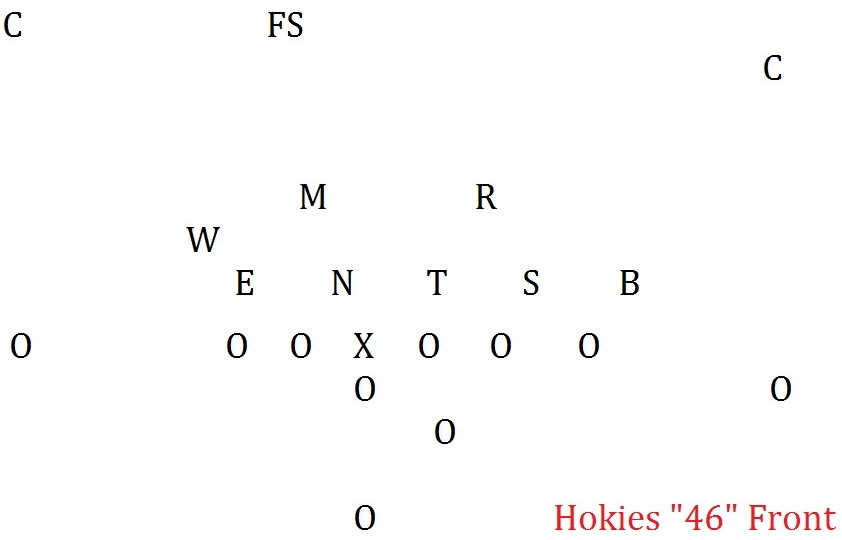
When teams often run to the strength of the formation, the Hokies like to use this front, allowing the strong side tackle (T), end (S), and linebacker (B) to that side to fill those gaps and leave the Rover (R) free to chase the ball and make a play.
Against William & Mary's spread offense sets, the Hokies played a great deal of their "G" front, which is more similar to the 4-4, with the Rover and Whip acting like outside linebackers.

Since the Rover and Whip are fairly undersized, their goal in this front is to act as the "Force" player in outside runs, using their speed to get upfield quickly and forcing the ball carrier to cut back into the heart of the defense.
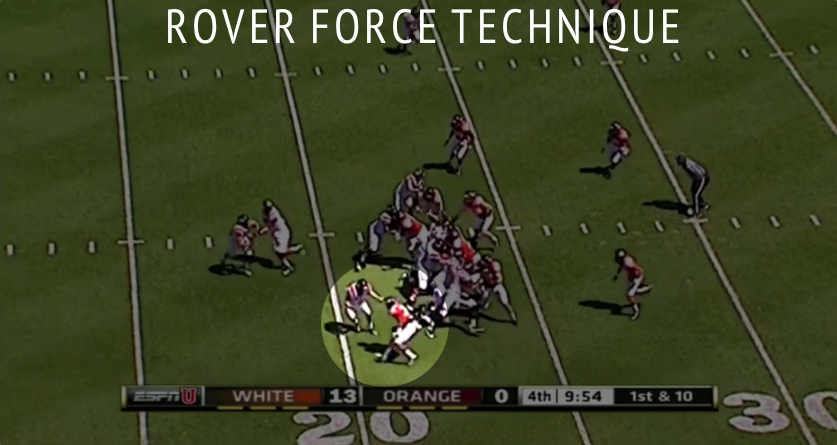
As we can see in both examples though, the secondary plays a "one high" look, meaning the free safety is all alone in the deep middle of the field. In week one, that led to a lot of "cover 1" man-to-man coverage, with the free safety playing centerfield behind them and reading the eyes of the quarterback. To help cause problems underneath, the middle linebackers often sat back and read the quarterback as well in these situations, creating a "robber" defensive look.
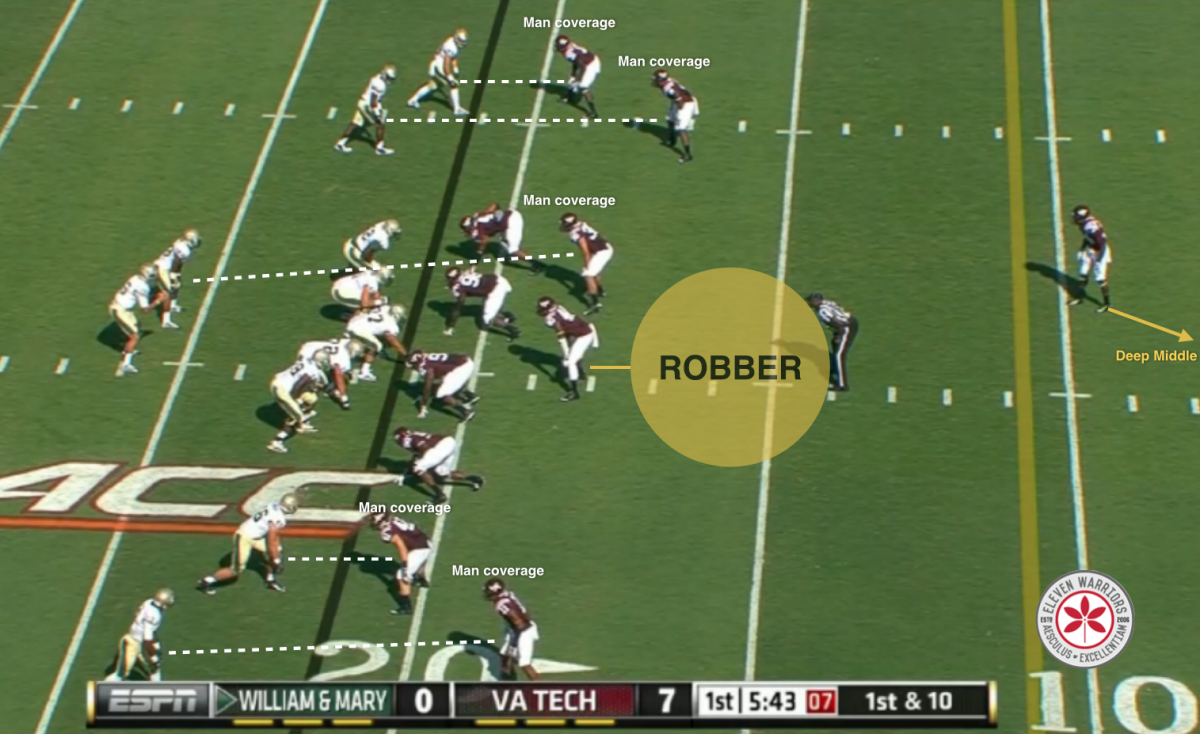
As we can see, when in the "G" front, the whip and rover walk out and cover slot receivers when teams line up in 4-wide sets, but will try to keep those players in favorable matchups, such as the whip covering a tight end, as we can see from #41 Derek Di Nardo above.
But when offenses often line up with three or four wide-outs, VT is more than happy to operate in their Nickel package, removing the whip for a third cornerback. With this lack of size, the Hokies will get creative with their coverages, moving in and out of man-to-man and zone from one play to the next.
Given the talent they've accumulated at the position and the coaching expertise on-hand, Beamer and Foster put a lot of faith in their cornerbacks. One-time Ohio State target Kendall Fuller steps in as a starter this year, but has already shown that he has the athleticism needed to man the outside alone.
Though the OSU receiving core looked solid in week one against Navy, this is a group that has had serious trouble getting open against press coverage in the past, leaving little doubt that the Hokies will test them early and often with this look.
When they do play a zone, the Hokies have been known to run an "Inverted Cover 2" that swaps the roles of a traditional "cover 2" defense, giving the corners responsibility for the deep halves and bringing the safeties up to help stop the run. Against William & Mary, the Hokies showed it sparingly, preferring it only when the Nickel package was on the field.
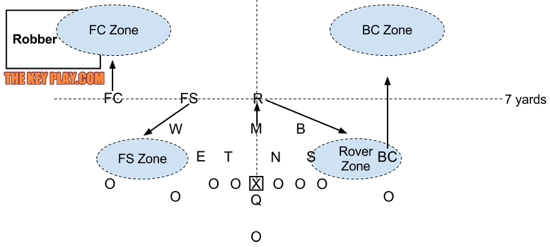
Finally, with so much talent in the secondary, Foster dials up an array of zone blitzes on third downs. In an effort to confuse their opponents before the snap, the Hokies will crowd the line of scrimmage, showing blitz from up to seven or eight defenders.
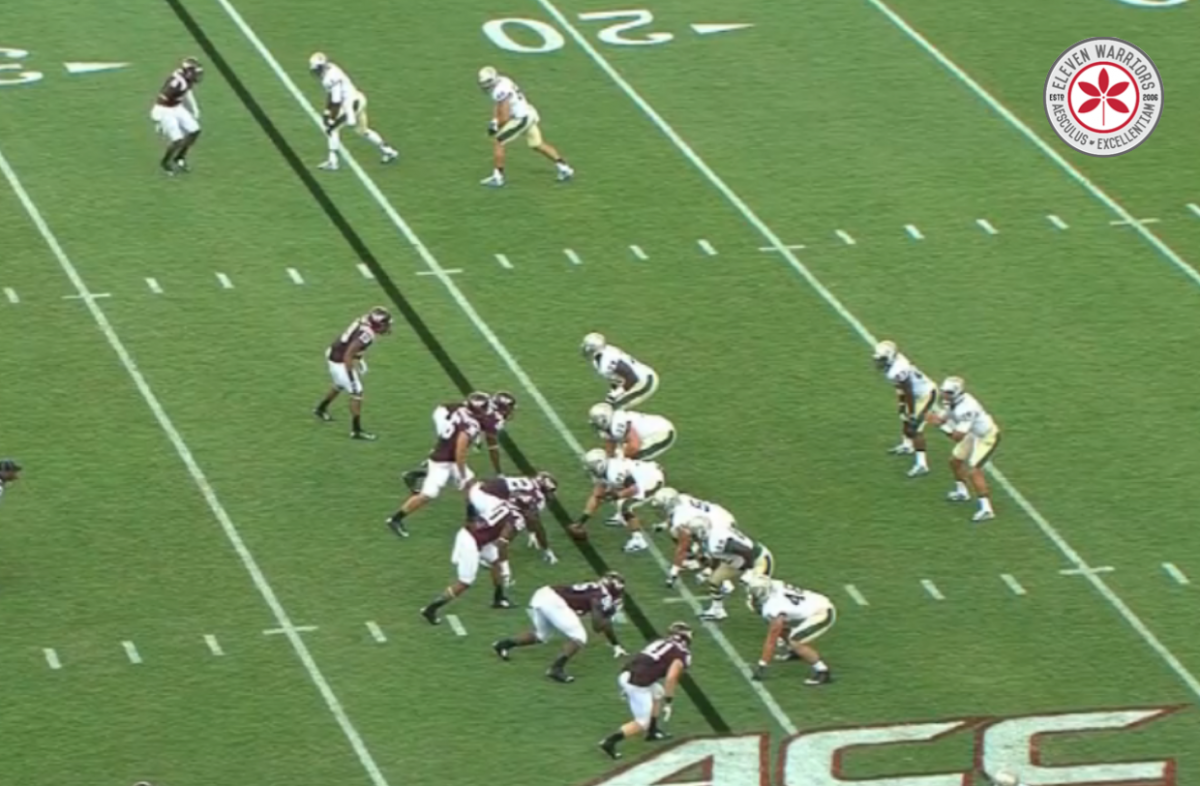
At the snap though, they'll often rush just five, leaving the offensive line to identify and properly pick up the blitzers.
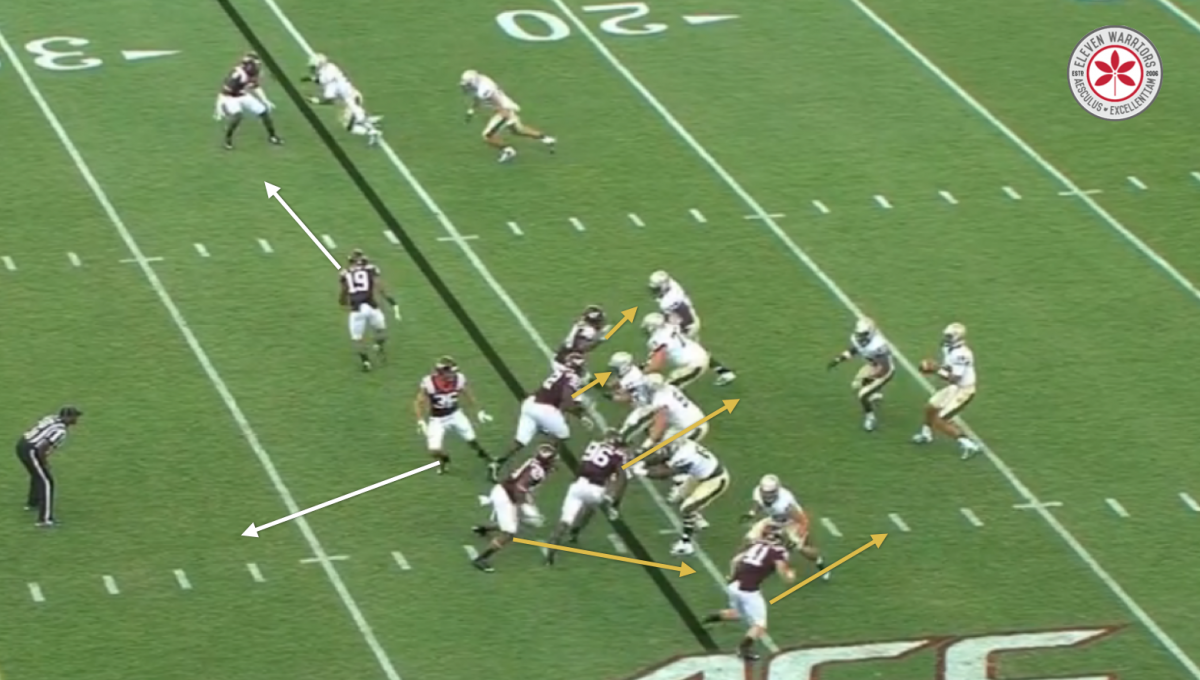
To make things even more difficult, they'll often delay the blitz of a linebacker, waiting for the offense to think they have everyone picked up before rushing the passer. This exact kind of blitz left Chase Williams unblocked in week one, allowing him to get a free shot on the QB and cause a fumble.

With good talent up front in nose tackle #92 Luther Maddy and stud end #90 Dadi Nicolas, the Hokies will do everything they can to overwhelm a young Buckeye offensive line that had some communication issues in week one against Navy. They've also been know to operate from two and three man fronts in the nickel, creating even more questions for opposing offensive lines.
For the Buckeyes to succeed offensively, they'll have to attack the alleys knowing that the cornerbacks playing man coverage aren't watching the backfield, leaving a lot of responsibilities on the whip, rover, or nickelback to make these stops.
One such play could be the outside zone sweep we saw quite a few times against Navy, looking to get the ball to that alley quickly by using the speed of H receivers Dontre Wilson and Jalin Marshall.
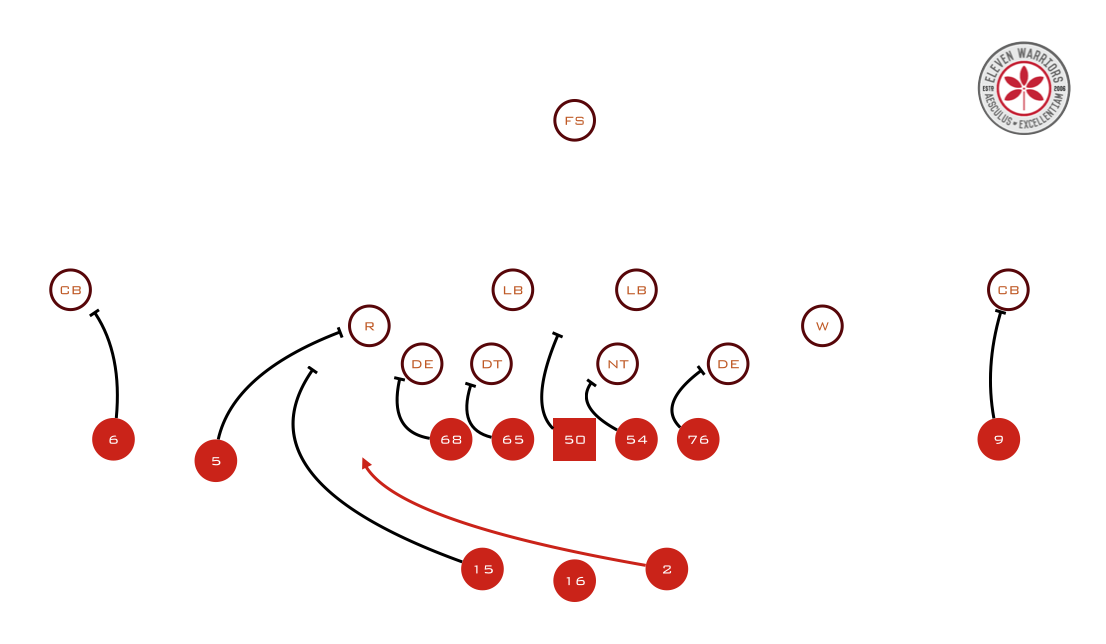
William & Mary saw success in the running game when they tried to get more bodies to one side on a sweep, but their backs had nowhere near the speed of Wilson. By bringing an extra body to block in running backs Ezekiel Elliott or Rod Smith, the Buckeyes create a numerical advantage to the play side, neutralizing the Hokies' extra defender in the box (in this case, the whip).
For VT to stop this, they'll have to either get their inside linebackers or free safety to that alley quickly while avoiding the extra OSU blockers, or win a one-on-one battle on the defensive line. To stop that penetration, one can surmise that the Buckeyes will run quite a bit behind left tackle Taylor Decker (#68), the only returning starter from 2013 and easily the most talented member of the line.
Undoubtedly, OSU will also still try to establish the Tight Zone inside, but with man coverage on the outside and only one deep safety, the Buckeyes will be facing at least a six man box with only 5 blockers. Barrett will have to establish the threat of pulling the ball on a read-option to neutralize one of the defensive ends, either keeping to run for himself, or throwing a quick pass like we saw quite a bit in week one.

Like the example above, I expect OSU to use quite a few formations with three receivers to one side, leaving the Hokies to declare their man coverage and leaving fewer defenders to the opposite side, or forcing them to move into a zone, where the Buckeye receivers should be more comfortable.
In the passing game, the Buckeyes will need to call on their inside receivers to make plays. Though the Hokies have outstanding coverage players on the outside with their corners, the Rover and Whip are hybrid players that don't specialize in man coverage. Much of the quick and intermediate passing game we saw in the OSU Spring Game will likely be called a bit more than it was against Navy in order to take advantage of these situations.
All in all though, for Ohio State to succeed offensively, they must be successful on first and second downs. They will not have the luxury of a passive defense sitting back on third down, as they did against Navy. The Hokies have a clear upper hand there, with both the personnel and scheme to cause serious trouble for this Buckeye team in that situation.
That doesn't mean the Buckeyes have to change too much though. With the exception of maybe the cornerbacks, OSU is still the bigger and faster team overall on both sides of the ball. While I expect a relatively low-scoring affair Saturday night, whichever team breaks more big plays will come out with the W.
For the Buckeyes, that means keeping it simple and getting the ball in the hands of playmakers like Wilson, Elliott, and others, hoping their athleticism springs a big play.
For the Hokies, that means forcing long third downs and creating chaos for a young quarterback and offensive line, looking to cause turnovers.
However it plays out, it should be a lot of fun to watch. See you in the 'Shoe.
